
J. Ross Baughman
[Editor’s Note: On the eve of the 70th anniversary of the June 6, 1944 Allied invasion of Normandy (commonly referred to as D-Day), photojournalist J. Ross Baughman emailed me the following thoughts on Robert Capa’s iconic “Magnificent Eleven” exposures of the event. Speaking from his perspective as an experienced front-line photojournalist, Baughman raises significant questions about the legends that have come to surround these images, both Capa’s production of them and their subsequent fate. In the first half of this two-part series, he weighed the published accounts and visual evidence of Capa’s brief involvement in the landing. Now he questions the standard narrative of what happened to those negatives when they reached London. — A. D. C.]
•
Robert Capa’s Troubles on Omaha Beach (2)
A careful examination of the D-Day negatives tells a very different story.
by J. Ross Baughman
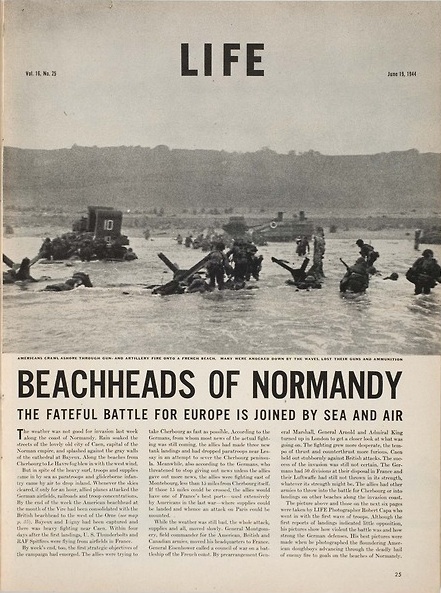
“Beachheads of Normandy,” LIFE magazine feature on D-Day with Robert Capa photos, June 19, 1944.
In various published accounts, John Morris lays out a time-line for LIFE‘s efforts on D-Day. The invasion itself opens at dawn on Tuesday, 6 June 1944, and Capa is among the first wave of 3,000 troops on Omaha Beach at 6:30 a.m. By 8:00 a.m., Capa is aboard a hospital ship on the way back, although Morris has no idea of this. By late afternoon Capa reaches England, and poses smiling for a portrait by fellow LIFE photographer David Scherman in Portsmouth. Although one account of Capa’s day says that the Burberry raincoat was the first thing thrown down into the bloody water on Omaha Beach, he’s wearing just such a coat for Scherman’s photo.
Capa’s packet of film arrives at LIFE‘s London offices about 9 p.m. on Wednesday the 7th, a lag of 35 or more hours for the 75-mile trip from Portsmouth. The absolute deadline for Morris to ship the film to America falls the next morning at 9:00 a.m.
“John, the film was all ruined,” announces Dennis Banks, one of LIFE‘s darkroom technicians. “You were in such a hurry I put them into the drying cabinet and closed the door and the emulsion ran.”
“I couldn’t believe it, but I ran back to the darkroom with him and held the rolls up to the light, one at a time; but there was nothing on the first three rolls. It was just pea soup.
“On the fourth roll, there were eleven frames with images, and I ordered them all to be printed.”
•
Unfortunately, this explanation raises more questions than it answers.
If the emulsion melted and ran, the heat had to have been most intense near the top of the cabinet. Therefore, the eleven frames that did survive would have filled the foot and a half of one strip near the relatively cooler lower part of the small, wooden closet.
If this is true, plain science leaves us with two nagging problems.
- When the drying cabinet door is closed, and this causes the heat to rise, the four rolls of film would have reacted with some similarity. Yet all of the salvaged images came from one roll instead of the coolest bottom portion of each roll.
- Moreover, the “running” emulsion from the top of the one lucky strip would have bled down, streaking onto the frames at the bottom.
But there is no trace of this happening on the well-known eleven frames.
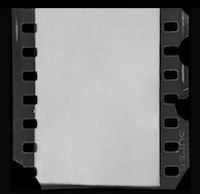
* “Behind the Photo: Robert Capa’s D-Day” (2014), screenshot
After forty years as a professional photographer, I have seen many different ways that negatives can be spoiled in the darkroom. Stray light can fog film, as can x-rays, extreme heat prior to development, or a variety of exhausted or contaminated chemicals. Any of these problems can cause a horrible muddying of the entire film surface (even the unexposed sprocket areas) into something resembling “pea soup.”
Extreme heat could have caused the emulsion to become very tender, and rather more prone to scratching or peeling; but not to change a normal negative into something uniformly opaque. I have seen properly developed film after its final wash that was then subjected to terrible heat, causing the film itself to warp and buckle, or the emulsion to blister and crack like old paint.
None of that can be seen on the “ruined” frames from Capa’s film.
The sprocket areas are clear, and we can see the same odd sprocket alignment in a comparison of the good frames to the other spoiled ones. We also see well-defined frame lines separating each of the ruined pictures. There is no trace of “running” or melted emulsion on or surrounding any of these frames. [Editor’s note: Click here for “Behind the Photo: Robert Capa’s D-Day,” a brief TIME video of John Morris’s account of the development and supposed loss of Capa’s images, including the damaged portions of the partially salvaged roll to which Baughman refers.]
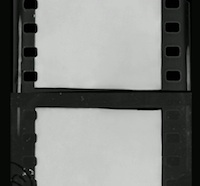
* “Behind the Photo: Robert Capa’s D-Day” (2014), screenshot
What we do see is a severe, heavy build-up of bright light onto each of the lost images. As black & white film negatives, these appear as dark solid rectangles, or when printed, as blown-out, blank-white fields. The oddly aligned sprocket holes show that this light was the result of an exposure through the camera lens, just like the pictures that turned out as usable. These are not the kinds of light leaks caused by an accidental opening of the camera back or a cracking of the finished film cassette.
The resulting exposures are consistent with what would happen after a very long, mistaken exposure time. This could happen if a shutter speed control dial was mistakenly pushed over to a half- or full-second. The extreme over-exposure could also result from tripping the shutter without a lens even mounted to the front of the camera.
The Omaha Beach pictures from Capa’s camera that survive all happened in two tight sequences, and within the first few minutes of his arrival. After that happens, we see every remaining shot ruined by catastrophic over-exposure. Perhaps the same camera that made the first few proper exposures was then badly soaked by sea water, or jolted, or damaged in some other way?
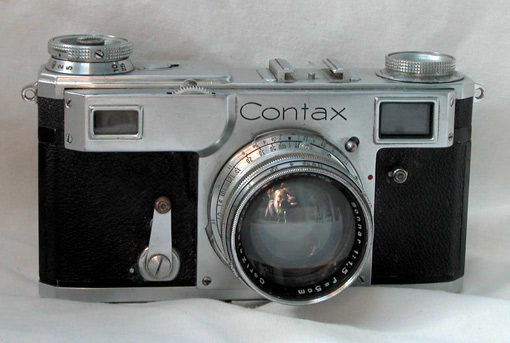
Contax II 35mm rangefinder camera with Carl Zeiss Jena 5 cm f/1.5 high-speed lens.
Might it have been that in the middle of battle, Capa mistakenly changed the shutter speed himself? Capa mentions carrying and using two Contax cameras, but is it likely that the same malfunction would have occurred with both cameras, one after the other? A photographer determined not to give up would have simply reached for one of the other two back-ups he was carrying. A really determined photographer could have suffered the break-down of all his equipment, but somehow manage to borrow or scrounge another on the scene, or send word back word for an emergency shipment. Surely the U.S. Army would have helped him with a loaner or two.
After all this, we get one fascinating, slightly enigmatic quote from Capa: “I would never have worked for LIFE again if they had fired Dennis Banks for ruining my negatives.” (Attributed to him sometime in July 1944.) That one sentiment puts a comforting blanket over the whole thing. It even sounds noble at first blush, but it camouflages the fact that Dennis Bank didn’t ruin Capa’s negatives. Capa did.
•
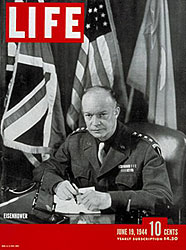
LIFE magazine, June 19, 1944 issue, with Robert Capa’s D-Day images and official U. S. Army Photo of Gen. Eisenhower on cover.
It’s a complex story for sure.
For all of his beautiful photos, his nerve, charisma, story-telling skills — even his untimely and tragic death in Vietnam — Capa deserves respect and our fond memories.
But for what he did on D-Day, now precisely 70 years ago, should anyone ever wish that they might follow in his steps?
Is what we treat as one of Capa’s best efforts something we can continue to hold up as a lesson in bravery, professionalism, and competence, one to be honored and emulated?
To recap: An egotistical dandy puts himself in the path of danger, but for the wrong reasons. He finds himself running behind his own reputation and ability to deliver. When all those about him are losing their heads (literally), he does, too (but only emotionally). When the pressure reaches a peak, he blows it technically. While there are compelling, powerful, historical reasons to buckle down and stick with it, he quits instead. Back home, he leaves his editor and biggest supporter hanging on deadline, and then lets someone else take the blame for his shortcomings.
A newspaper editor in Washington once shared with me a valuable lesson that seems to apply here: Know your own limitations.

Overseas Press Club logo
The Overseas Press Club is an old and venerable association of journalists formed 75 years ago, and each year they award one of their most distinguished gold medals named in honor of Robert Capa. It is meant to single out a photographer who demonstrates Capa’s same courage and enterprise during the coverage of a dangerous international story. Journalists, perhaps above all other groups, must be clear-eyed about the stories they tell themselves as well as the rest of the world.
•
(Click here for Part 1. For an index of links to all posts in this series, click here.)
(To see all of Capa’s D-Day images at the Magnum website, click here.)
[Editor’s note: Subsequent research by Rob McElroy revealed that all supposed examples of Capa’s “damaged” D-Day negatives published in the May 29, 2014 TIME video, such as the ones above (*), were forgeries produced by Magnum in collusion with the International Center of Photography. While this renders irrelevant the above analysis of those frames, it does not undermine Baughman’s broader challenge to the “melted emulsion” narrative. — A. D. C.]
•

J. Ross Baughman
In 1978, at the age of 23, photojournalist J. Ross Baughman became the youngest professional ever awarded the Pulitzer Prize, and was cited for his coverage of the guerrilla war in southern Africa. While continuing to work that same year as the first contract photojournalist ever hired by the Associated Press, he competed against himself with two other nominations: For infiltrating the American Nazi movement over nine months to uncover their assassination and bombing plans and once more for being the first journalist to ever accompany Palestinian commandos operating behind Israeli lines.
Baughman soon went on to become an international lecturer on journalism ethics, a university professor and founder of the photo agency Visions, which specialized in long-term, high-risk, difficult-access investigative photo essays around the world. Besides covering wars in 11 countries, his work has appeared everywhere from LIFE to Vanity Fair, Newsweek, Time, Stern, The New York Times Magazine and Vogue.
Some of his writings and photographs may be seen at Wikipedia and at his own website. For his previous Guest Post, click here. To contact J. Ross Baughman, click here.






I have never seen the negatives but always wondered how some rolls and not others were ruined in the same dryer. Wonderful article – it does not diminish any about Capa for me. But shows he was human – photographing and being shot at and being in water – perfection was not an option in this case. Sad he blamed someone else for it though.
Casting the blame elsewhere got done not by Capa (at least initially) but by picture editor John Morris. I’ll discuss that in a follow-up to Baughman’s posts.
Thank you, A. D., for running this excellent pair of guest posts. And thank you, J. Ross, for delving deeply into the Capa mythology and delivering some clear-headed observations. As long as we’re on the topic, I’d like to ask a favor.
While writing about Magnum many years ago for an essay in Exposure, I became interested in the quote attributed to Robert Capa, which has inspired any number of enterprising, life-risking (and occasionally -sacrificing, RIP Tim Hetherington et alii) photo-journalists and “war photographers” in the Nachtwey mode. Of course, what I refer to is this: “If your pictures aren’t good enough, you aren’t close enough.”
One reason I linger on this statement is that there is a certain school of mural-printing, Düsseldorfian photographers who adopted an inversion of this commandment; if your pictures aren’t good enough, back the hell up. Way back. Get more diffident (and more marketable) by getting more distance, then printing the results large enough for people to be enthralled by the details while ignoring the generally banal forest.
But more to the Capa-demystifying point, I have not found nor heard any conclusive linking of this statement to the demi-god himself. Can it be traced back to its source? Did the oracle issue this shibboleth in documented verbal form, or write it down somewhere? Or has it simply risen to the surface of the Magnum myth, having become a necessary, if apocryphal, fiction?
If there’s a simple answer, a source I hadn’t found, one of you might be kind enough to relieve me of this irksome lacuna. Like so much related to Cornell’s older brother, née Endre Friedmann, the legend seems to have occluded the truth.
Thanks.
George Slade
I don’t have my copy of Capa’s autobiography, Slightly Out of Focus (1947), close to hand, but this became commonly attributed to him long before that book saw print.
I’ll venture a guess that it’s something Capa said conversationally, on a regular basis, that entered the lore of the medium, so that pinpointing its moment of origin and a published source will prove impossible. But I’m not a Capa scholar — nor is Baughman. Perhaps one will chime in one this matter and instruct us.
With that said, the idea that one’s photos (or written reportage, for that matter) will improve the closer one gets to the action hardly strikes me as an original thought. It’s a fundamental principle of all journalism and, before that, of chronicling. Flavius Josephus would doubtless have said the same thing.
Capa’s terse locution — the sort of thing you’d say to Hemingway over a whiskey — has proved memorable, but that doesn’t make the concept his.
Would it be possible that the shutter in Capa’s Contax failed? The shutters in these cameras used silk straps on which the metal slats of the blinds slid through. This action wore the straps out and can cause them to break unexpectedly. With the tension around him and perhaps the need to shoot and wind quickly, the breakage could have occured at the least opportune moment.
Capa took two Contaxes with him to Normandy, which I’ve called Contax A and Contax B. We don’t know if he designated one as his favorite or not. We don’t know which one he used aboard the U.S.S. Samuel Chase en route to Omaha Beach. So we don’t know which one he used to make the exposures on the first three rolls of 35mm film he sent to London.
I’ve designated the camera he used at Omaha Beach Contax A, which he used to exposed the last 11 frames of what I’ve called Roll 4. Whatever caused the problems with the first two-thirds of that roll, it can’t have been shutter failure such as you describe, because the camera worked for the last exposures.
Moreoever, when he got back to England on the Chase he turned around and returned to Normandy, following the Allies through France for the next month, with the same equipment, which apparently gave him no difficulties. So the explanation must lie elsewhere.